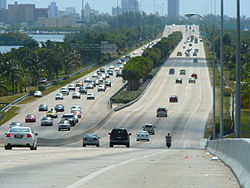| Julia Tuttle Causeway | ||||
| Route information | ||||
| Auxiliary route of I-95 | ||||
| Maintained by FDOT | ||||
| Length | 4.42 mi[1] (7.11 km) | |||
| Existed | December 23, 1961[citation needed]–present | |||
| NHS | Entire route | |||
| Major junctions | ||||
| West end | ||||
| East end | ||||
| Location | ||||
| Country | United States | |||
| State | Florida | |||
| Counties | Miami-Dade | |||
| Highway system | ||||
| ||||
Julia Tuttle Causeway | |
|---|---|
 The Julia Tuttle Causeway eastbound connecting Midtown Miami with Miami Beach | |
| Carries | 6 lanes of I-195 |
| Crosses | Biscayne Bay |
| Locale | Miami |
| Characteristics | |
| Design | Beam, fill causeway |
| Material | Slabs and girders |
| Total length | 2.5 miles (4.0 km) |
| Longest span | 0.4 miles (0.64 km) |
| Clearance above | 68 feet (21 m) |
Interstate 195 (I-195) is a 4.42-mile-long (7.11 km) auxiliary Interstate Highway connecting I-95, its parent route, in the west with Miami Beach in the east. It crosses Biscayne Bay by traveling over the Julia Tuttle Causeway. The causeway is named after Miami founder Julia Tuttle.
It is part of the longer State Road 112 (SR 112), which continues to the west as the Airport Expressway and to the east as Arthur Godfrey Road (41st Street).
As part of a pilot program, the Florida Department of Transportation painted the shoulders as bike lanes east of US Highway 1 (US 1). Pedestrians are still prohibited.
- ^ Starks, Edward (January 27, 2022). "Table 2: Auxiliary Routes of the Dwight D. Eisenhower National System of Interstate and Defense Highways". FHWA Route Log and Finder List. Federal Highway Administration. Retrieved January 1, 2023.

